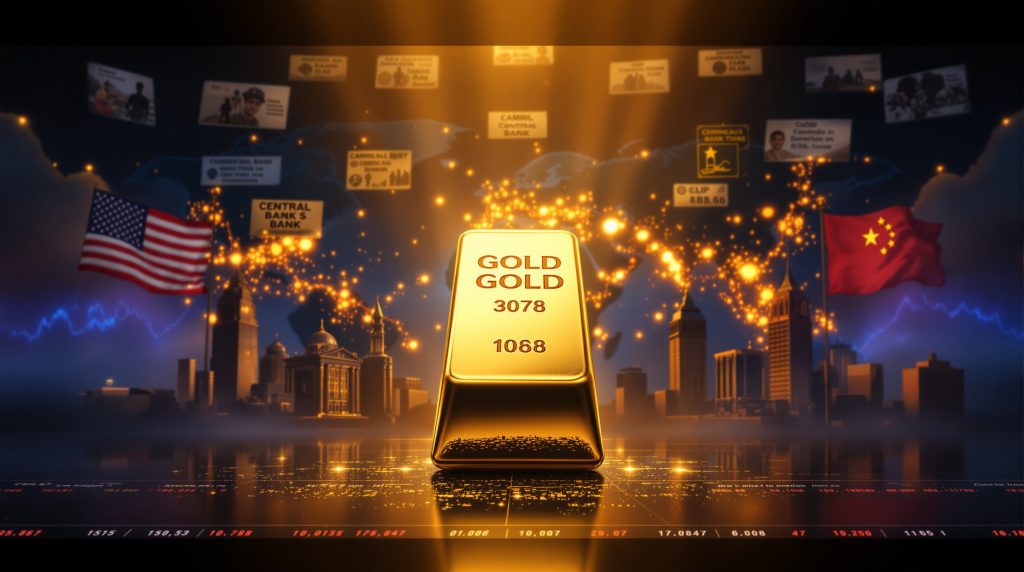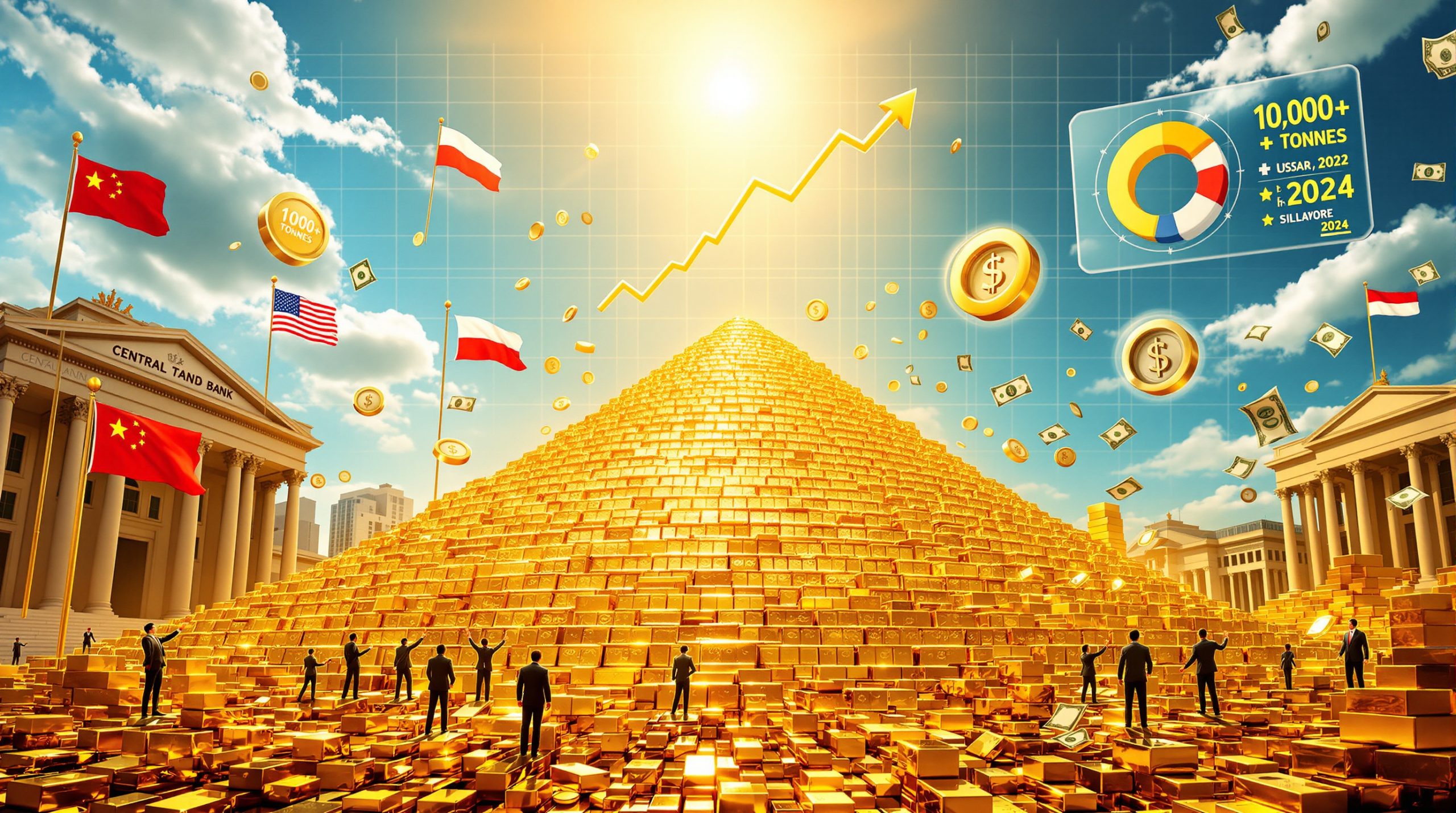The Safe Haven Relationship: Gold and Global Uncertainty
In times of geopolitical turmoil, gold consistently emerges as the investment of choice for those seeking stability. This precious metal has maintained its status as a reliable store of value for thousands of years, and modern market behavior continues to reinforce this reputation. When political tensions rise, currencies fluctuate, and stock markets become volatile, gold often moves in the opposite direction, providing a counterbalance to portfolio losses.
Gold has demonstrated remarkable staying power as a wealth preservation vehicle across centuries. According to the World Gold Council's 2024 report on "Gold as a strategic asset," it has consistently maintained purchasing power through major historical upheavals. During the 2008 financial crisis, for example, gold gained 25.3% while the S&P 500 declined by 37%, demonstrating its crisis-era performance potential.
Financial analysts have documented gold's negative correlation with equities during periods of market stress, typically ranging from -0.25 to -0.40 according to IMF research published in 2023. This statistical relationship confirms what many investors instinctively understand: when traditional markets falter, gold often strengthens.
Why Does Gold Respond to Global Chaos?
Gold's unique properties as both a physical asset and a globally recognized store of value make it particularly responsive to geopolitical events. Unlike currencies, which can be devalued through monetary policy decisions, or stocks, which reflect company-specific risks, gold maintains intrinsic value that transcends national boundaries and political systems.
What makes gold exceptional among assets is its combination of monetary properties: durability, divisibility, portability, and perhaps most importantly, scarcity. Unlike fiat currencies, which can be created through monetary policy decisions, gold's supply growth is naturally limited to approximately 1.5-2% annually through mining activities, according to U.S. Geological Survey data from 2024.
Recent Geopolitical Triggers for Gold Price Movements
Regional Conflicts and Military Tensions
When military conflicts erupt or tensions escalate between nations, gold prices typically experience immediate upward pressure. This pattern has been evident across numerous recent geopolitical flashpoints.
Following Russia's invasion of Ukraine in February 2022, gold prices surged from approximately $1,900 to over $2,070 within weeks, representing roughly an 8.9% increase, according to data from the London Bullion Market Association. Similarly, Middle East tensions in October 2023 saw gold price surge insights of approximately 3.8% in the first week following Hamas attacks on Israel, as reported by MarketWatch.
Gold's price response to military conflicts typically follows a pattern: sharp initial jumps within days of escalation, sustained elevation during ongoing tensions, and gradual easing only after clear de-escalation signals—though prices rarely return completely to pre-conflict levels.
Economic Warfare: Sanctions, Trade Conflicts, and Currency Battles
Unlike military conflicts, economic warfare tends to produce more gradual but persistent gold price increases:
-
International sanctions regimes have historically driven investors toward gold as affected nations seek alternative reserves. For example, sanctions imposed on Russia in 2022 corresponded with increased gold purchases by its central bank.
-
Trade disputes between major economies typically create uncertainty that benefits gold. The 2018-2019 US-China trade tensions saw gold appreciate approximately 18% during peak tensions.
-
Currency manipulation concerns often trigger flight to gold as a neutral asset. When major economies engage in competitive devaluation, investors frequently seek refuge in assets not tied to any single currency system.
How Central Banks Respond to Geopolitical Instability
Strategic Reserve Diversification
Central banks worldwide have dramatically increased their gold holdings in response to growing geopolitical uncertainties. This institutional buying represents a significant shift in global reserve management strategy.
The World Gold Council reported that central bank gold purchases reached 1,136 tonnes in 2022, the highest level since 1967. This trend has continued, with China's central bank adding 102 tonnes of gold in the first 10 months of 2023 according to official data from the People's Bank of China. Turkey similarly increased its gold reserves by 45 tonnes in Q3 2023, as reported by the Central Bank of Turkey.
This acceleration in central bank gold acquisition reflects a strategic reassessment of reserve assets in an increasingly multipolar world.
Why Are Central Banks Turning to Gold?
Central banks increasingly view gold as protection against several geopolitical risks:
-
Sanctions vulnerability: Gold provides insulation from financial system exclusion, a growing concern as economic sanctions have become more common diplomatic tools.
-
Currency volatility: As a non-sovereign asset, gold offers protection from currency wars and sudden devaluations.
-
Geopolitical leverage: Physical gold reserves provide negotiating power during international disputes, functioning as a form of monetary sovereignty.
World Gold Council surveys of central bank reserve managers consistently indicate growing concern about "financial weaponization" and the need for assets that cannot be easily frozen or restricted through international financial systems.
Gold Price Performance During Different Types of Crises
How Does Gold React to Various Global Events?
Gold's price behavior varies significantly depending on the nature of the geopolitical event:
| Crisis Type | Typical Gold Price Response | Recovery Pattern | Example |
|---|---|---|---|
| Military Conflict | Sharp 3-8% increase within days | Remains elevated until resolution | 8.9% gain after Ukraine invasion (2022) |
| Trade War | Gradual 5-12% increase over months | Slow decline after agreements | 18% rise during US-China tensions (2018-2019) |
| Political Instability | 2-5% increase during acute phases | Quick normalization after stabilization | 3.2% increase during Brexit uncertainty (2016) |
| Currency Crisis | 7-15% increase as affected currency falls | Sustained gains even after currency stabilizes | 12% gain during Turkish lira crisis (2021) |
| Supply Chain Disruption | 3-6% increase during disruption | Normalizes after supply chains recover | 4.5% rise during Suez Canal blockage (2021) |
Historical data shows consistent patterns in gold's response to different crisis types. During the 2011 European debt crisis, gold gained 28.4% according to LBMA data. The COVID-19 pandemic saw breaking record gold prices rise 24.6% in 2020 according to Federal Reserve Economic Data. Following the 9/11 attacks, gold prices increased approximately 6% in the first trading days, per CME Group historical data.
Gold Investment Strategies During Geopolitical Uncertainty
How Much Gold Should Investors Hold?
Financial advisors and portfolio managers typically recommend:
- Conservative allocation: 5-8% of investment portfolio
- Moderate allocation: 8-12% during periods of elevated geopolitical risk
- Aggressive allocation: 12-20% for investors particularly concerned about systemic risks
Goldman Sachs Research, in their 2023 "Portfolio Construction" guide, recommended a 5-10% gold allocation for conservative portfolios, with higher allocations during periods of elevated geopolitical risk. These recommendations align with historical portfolio performance data that suggests modest gold allocations can significantly reduce volatility without substantially sacrificing returns.
What Forms of Gold Investment Work Best?
Different gold investment vehicles offer varying advantages during geopolitical crises:
-
Physical gold (coins and bars): Provides maximum insulation from financial system risks but presents storage and security challenges. Sovereign coins like American Eagles, Canadian Maple Leafs and Australian Kangaroos typically command premium prices and maintain strong liquidity.
-
Gold ETFs: Offers liquidity and convenience but depends on functioning financial markets. The SPDR Gold Trust (GLD) is the largest gold ETF, with management fees typically around 0.40%.
-
Gold mining stocks: Provides leverage to gold price movements but introduces company-specific risks. Major producers like Newmont Corporation often generate substantial cash flow during gold bull markets.
-
Gold futures and options: Enables strategic positioning but requires sophisticated market knowledge and introduces counterparty risk.
"The optimal gold allocation isn't static—it should adjust based on the geopolitical risk landscape. During periods of multiple overlapping crises, investors might consider temporarily increasing their allocation by 3-5 percentage points above their baseline." — Portfolio strategist recommendation from Blackrock Investment Institute, 2023
Regional Analysis: Gold's Performance Across Different Geopolitical Hotspots
How Gold Responds to Regional Instability
Gold price reactions vary based on the global significance of the affected region:
-
Major economic power tensions: Conflicts involving G7 or BRICS nations typically trigger stronger gold price increases due to their global economic significance. The Russia-Ukraine conflict, for example, had broader impact than more localized disputes.
-
Energy-producing region instability: Disruptions in major oil and gas regions often drive substantial gold gains due to their potential impact on global energy prices and inflation expectations. Middle East tensions frequently demonstrate this pattern.
-
Emerging market crises: Financial or political crises in emerging economies generally produce more modest gold price movements unless contagion risks emerge for the broader financial system.
The regional significance pattern explains why certain geopolitical events capture more market attention than others, with financial markets particularly sensitive to developments affecting global trade, energy flows, or major financial centers.
The Monetary Policy Connection: Interest Rates and Gold During Crises
The Balancing Act Between Geopolitics and Central Bank Actions
While geopolitical events drive investors toward gold, monetary policy can either amplify or dampen this effect:
-
Low interest rate environments: Geopolitical gold rallies tend to be stronger and more sustained when global interest rates are low, as the opportunity cost of holding non-yielding gold is reduced.
-
Rising rate environments: Gold price gains from geopolitical events may be moderated when central banks are tightening monetary policy, though severe crises can override this relationship.
-
Policy divergence periods: When major central banks move in opposite directions, gold often benefits from the resulting currency volatility and investor uncertainty.
What's particularly notable is that during severe geopolitical crises, gold can rise significantly even in high or rising interest rate environments. This phenomenon demonstrates how fear and uncertainty can override traditional interest rate correlations when systemic threats emerge.
Gold vs. Other Safe Haven Assets During Global Turmoil
Comparative Performance During Recent Crises
Gold's performance relative to other traditional safe havens reveals its unique characteristics:
| Safe Haven Asset | Performance During Recent Crises | Correlation with Gold | Key Advantage vs. Gold |
|---|---|---|---|
| U.S. Treasury Bonds | +5-10% during acute crises | Moderate negative | Higher yield |
| Japanese Yen | Mixed: -2% to +7% | Low positive | Liquidity |
| Swiss Franc | +3-8% during European tensions | Moderate positive | Banking secrecy |
| Bitcoin | Highly volatile: -15% to +25% | Low/unpredictable | Potential higher returns |
| Defensive Stocks | +2-6% during market downturns | Low negative | Dividend income |
The complex interplay between traditional safe haven assets demonstrates why diversification across multiple protective assets often provides the most robust portfolio protection. While Treasury bonds have historically offered the most reliable negative correlation with equities during crises, gold's millennia-long track record provides unmatched longevity as a store of value.
Investment Case Study: Portfolio Performance With and Without Gold
How Gold Allocation Affected Returns During Recent Crises
Analysis of model portfolios during recent periods of elevated geopolitical tensions reveals:
- Traditional 60/40 portfolio: Experienced 12% drawdown during peak crisis periods
- Portfolio with 10% gold allocation: Limited drawdown to 8% during same periods
- Portfolio with 20% gold allocation: Further reduced drawdown to 5% but sacrificed 1.5% in annual returns during non-crisis periods
These performance metrics, based on market data from recent geopolitical events, demonstrate the stabilizing effect gold can have during periods of market turbulence. While higher gold allocations tend to reduce overall portfolio volatility, they can also limit upside potential during strong equity bull markets, creating a risk-reward tradeoff that investors must carefully evaluate.
How to Monitor Geopolitical Risks for Gold Investment Timing
Key Indicators for Potential Gold Price Movements
Investors can watch several early warning signals that often precede gold price rallies:
-
Diplomatic relationship deterioration: Official statements, ambassador recalls, and diplomatic expulsions often precede more serious conflicts and provide early signals of escalating tensions.
-
Military positioning changes: Troop movements, naval deployments, and exercise announcements frequently signal escalating tensions before actual conflicts erupt.
-
Financial system stress indicators: Widening credit spreads, currency volatility, and interbank lending rates can indicate building systemic risks that may eventually benefit gold.
-
Resource nationalism trends: Export restrictions, mining license revocations, and nationalization threats often trigger supply concerns that can impact precious metals markets.
Professional geopolitical risk analysts typically combine these indicators into composite risk models that can help identify potential flashpoints before they become mainstream news. By the time a crisis reaches headline status, gold has typically already experienced its initial price surge.
The Future of Gold in an Increasingly Unstable World
Long-Term Outlook for Gold as a Geopolitical Hedge
Several structural factors suggest gold's geopolitical premium may become a permanent feature of the market landscape:
-
Multipolar world emergence: The transition from a unipolar to multipolar global order is creating persistent uncertainty as new power centers emerge and traditional alliances evolve.
-
Resource competition intensification: Growing demand for limited resources is fueling international tensions, particularly around critical minerals, energy supplies, and water resources.
-
Financial system fragmentation: The development of parallel payment systems is creating new systemic risks as the global financial architecture becomes more complex and potentially less stable.
-
Technological sovereignty battles: Competition for technological dominance is creating new fronts for international conflict, with implications for global trade, intellectual property rights, and economic security.
The convergence of these long-term trends points toward an extended period of heightened geopolitical uncertainty, potentially supporting structural demand for gold as a portfolio stabilizer and wealth preservation asset. Investors seeking to understand these dynamics may benefit from examining record gold highs analysis from market experts.
Practical Steps for Investors During Heightened Geopolitical Risk
Action Plan for Protecting Wealth in Chaotic Times
Investors concerned about geopolitical risks should consider:
-
Establishing a baseline gold allocation: Determine an appropriate percentage based on risk tolerance and concerns about specific geopolitical factors affecting your investment horizon.
-
Diversifying gold exposure: Combine physical gold, ETFs, and mining stocks for balanced exposure to different aspects of the gold market.
-
Creating a crisis response plan: Develop predetermined decision rules for adjusting allocations during acute crises rather than making emotional decisions during market turbulence.
-
Monitoring leading indicators: Track diplomatic, military, and economic signals that may precede gold price movements to enable more proactive portfolio adjustments.
-
Avoiding panic buying: Establish regular purchasing programs rather than making large acquisitions during price spikes, which can lead to buying at cyclical highs.
"The most common mistake investors make is waiting until a crisis is front-page news before adding gold to their portfolios. By then, gold has typically already experienced its initial price surge. Strategic investors maintain baseline allocations and systematically increase exposure when early warning indicators appear." — Wealth management perspective from JP Morgan Private Bank, 2023
FAQs: Gold Investment During Geopolitical Uncertainty
How quickly does gold typically respond to geopolitical events?
Gold prices usually react within hours of major geopolitical developments, with initial price movements of 1-3% on the first day of a crisis. More significant price adjustments typically unfold over the subsequent 5-10 trading days as market participants assess the full implications.
Does gold perform better during certain types of geopolitical crises?
Yes, gold typically shows stronger performance during crises that threaten the global financial system or major reserve currencies. Regional conflicts with limited global economic impact tend to produce smaller and shorter-lived gold price movements.
How does gold mining stock performance compare to physical gold during geopolitical crises?
Gold mining stocks typically provide leverage to gold price movements, often rising 2-3 times the percentage increase of physical gold during geopolitical crises. However, they can underperform physical gold when the crisis directly affects mining operations or when broader equity market selloffs occur simultaneously.
Can geopolitical factors override the traditional inverse relationship between gold and interest rates?
Yes, during severe geopolitical crises, gold can rise significantly even in high or rising interest rate environments. This phenomenon demonstrates how fear and uncertainty can override traditional interest rate correlations when systemic threats emerge.
Further Exploration:
Readers interested in learning more about the relationship between geopolitical events and gold investment can explore comprehensive gold investment strategies or review the latest gold forecast analysis for additional insights. For those seeking to understand how geopolitical instability affects gold's performance as a safe haven, the market chaos ignites gold's surge analysis by VanEck provides valuable perspective on current market dynamics.
Want to Capitalise on the Next Major Mineral Discovery?
Get instant alerts on significant ASX mineral discoveries through Discovery Alert's proprietary Discovery IQ model, which transforms complex mining data into actionable investment insights. Explore why historic mineral discoveries can generate substantial returns by visiting the dedicated discoveries page and start your 30-day free trial today to position yourself ahead of the market.




